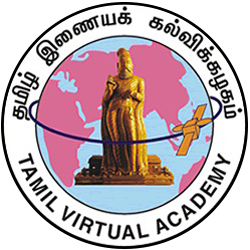Primary tabs
-
Lesson 6
Do6136 Rhythmic Structure in Isaipaadalgal
This lesson talks about the prosody (or yappu) of
musical compositions. Prosody (i.e. yappu ilakkanam) is
the study of the metrical structure underlying poems
and musical compositions. Music emanates from the
harmonious arrangement of sounds. Different terms such
as ‘santham’, ‘vannam’, ‘mettu’, and ‘kattalai’ are used in
Tamil to denote the rhythmic arrangement of sounds in
musical compositions. This lesson defines these terms. It
then analyses a few devotional hymns from ‘Thevaram’
and ‘Thiruppugazh’, some Kaavadichindu compositions
and folk songs noted for their rhythmic beauty and
metrical strength.Santham is the rhythmic arrangement of sounds in
musical compositions.Tholkappiar, the ancient grammarian,
calls it ‘vannam’ or tonal colour. According to him there
are 20 types of tonal colour. The classification of
vannam is on the basis of the arrangement of long and
short vowels and the syllable count. Information on
‘santha varna sorkal’ or words that resonate with tonal
colour can be found in the ‘Thevaram’. Similarly,
‘Thirusantha Virutham’ the devotional hymn composed by
Thirumazhisai Aazhwaar in ‘Nalaayira Divyaprabandam’
is famous for beauty of its santham and thaala.Adiyaarkku Nallar speaks of a musical unit called
“Kattalaya Geetham’ in his treatise on the grammar of
music. Kattalaya Geetham is the arrangement of
syllables according to thaala. The rhythmic or santha
structure in ‘Thevaram’ is called ‘kattalai’. In ‘Thevaram’
the kattali and the pan in which each hymn has to be
rendered are specified. The intricate santha structures
of the ‘Thiruppugazh’ hymns, sung by Arunagiriyar,
account for their musical appeal. The ‘Thiruppugazh’
verses are based on 24 santhams and occupy a
special place in thaala literature.Kaavadichindu is another devotional musical composition noted for its rhythmic lilt. Popularised by
songs were inspired by Arunagiriyaar’s ‘Thiruppugazh’.
Sennikkulam Annamalai Reddiyar, the kaavadichindu
The kaavadichindu compositions (‘kaavadi’ meaning the
ritual canopy and ‘chindu’ meaning song) are sung by
the devotees of Lord Muruga While going on
pilgrimages bearing the ‘kaavadi’ on their shoulders.
Sennikkulam Annamalai Reddiyar not only composed
several kaavadichindus but also set the tunes or
santha mettukkal for them. The melodic lilt and
simplicity of the kaavadichindu santhams have made
them immensely popular among the masses.Folk songs sung by the common folk are also
based on tunes. The entire gamut of folk songs which
includes ‘thaalaattu’, ‘maariamman paattu’, ‘oppari’,
‘erpaattu’ and ‘themmangu’ have simple metric tunes
that reflect the emotion of the singer.Musical compositions of sithars (i.e. mystics)
enjoyed great popularity among the common folk.
These compositions are based on 4 types of prosodic
structures: the metrical structure in traditional
versification, the santham structures found in minor
literature, the metrical forms of isaipa and the structure
of vilippadal.



